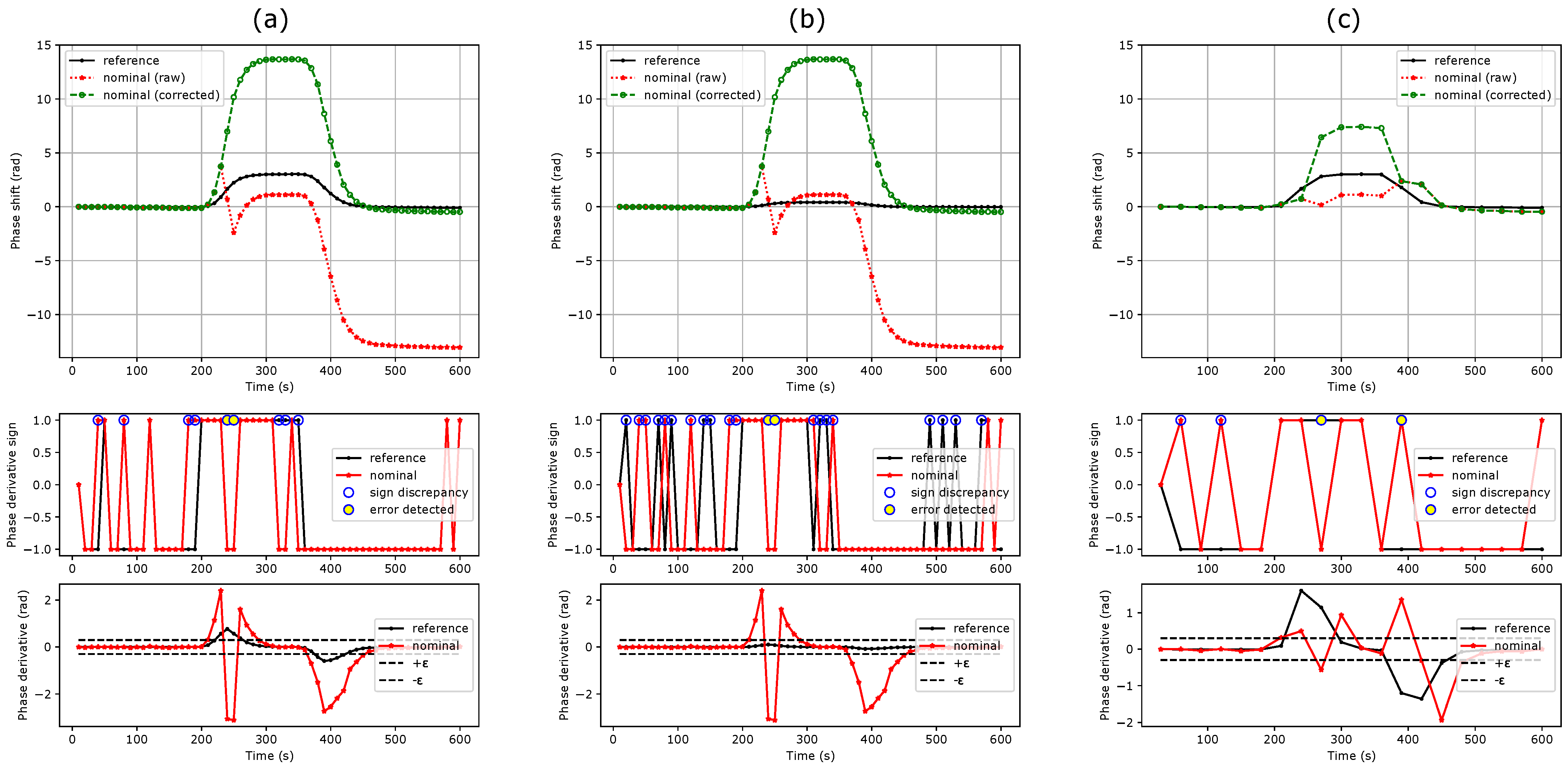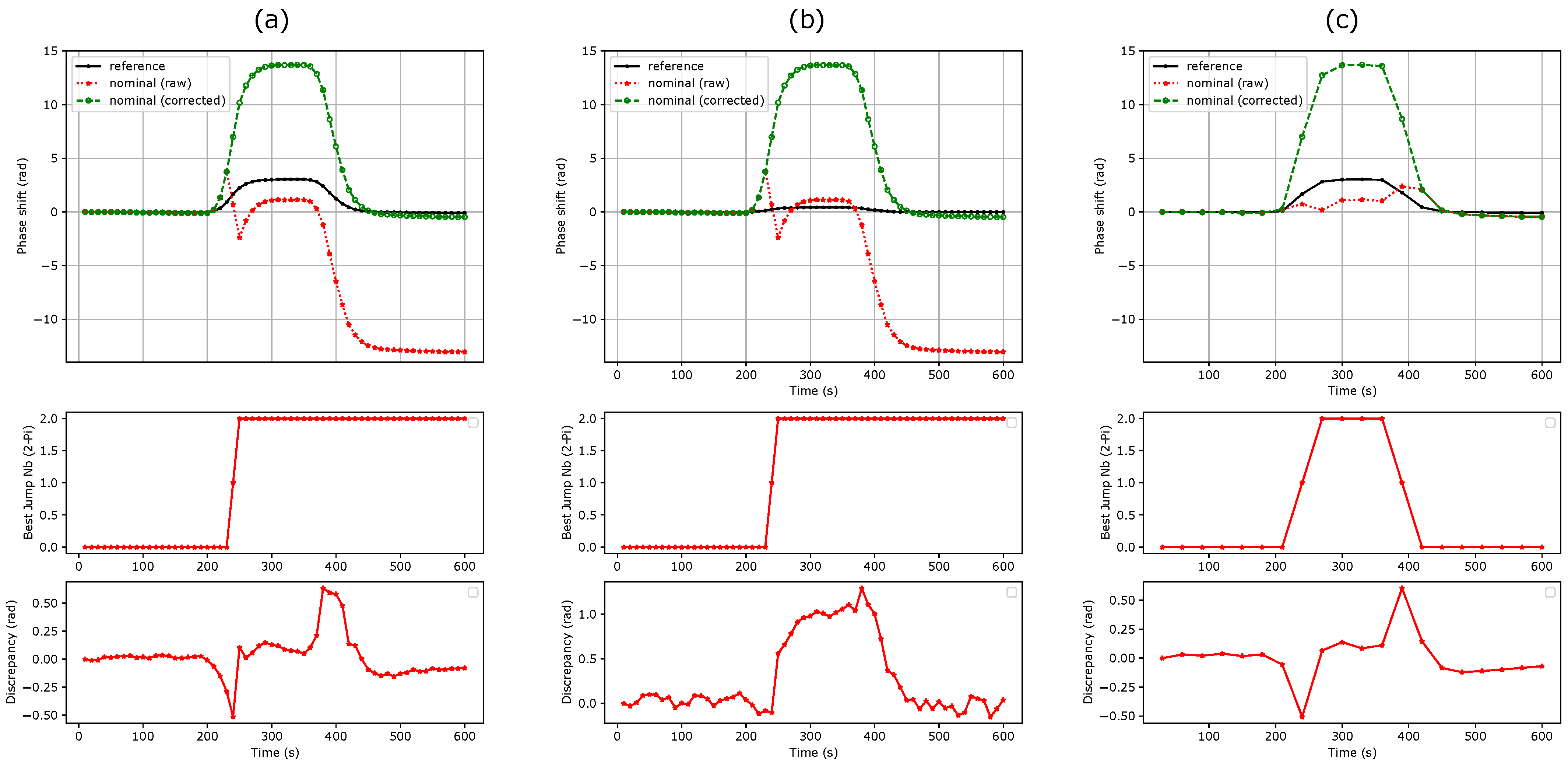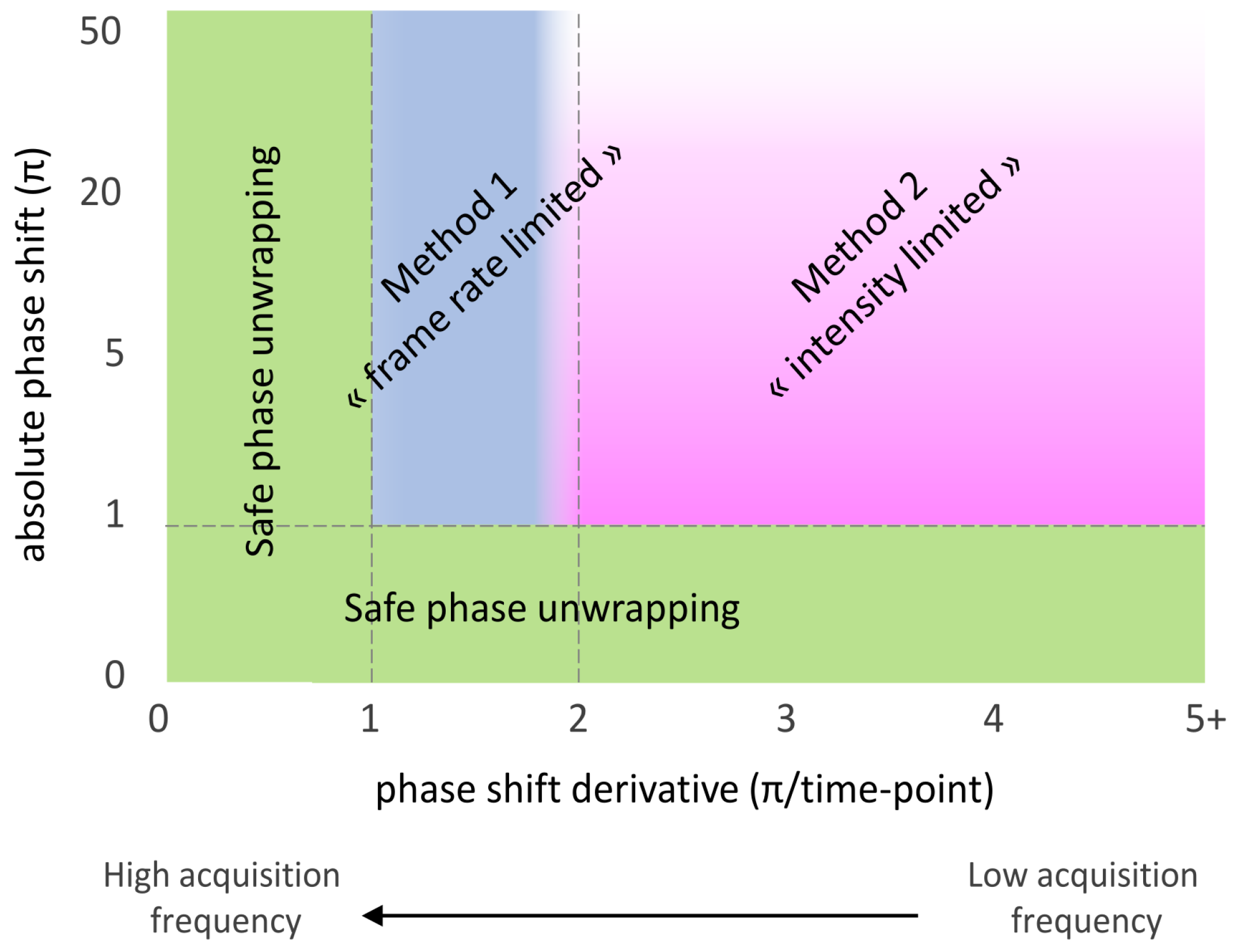Correction of 2π Phase Jumps for Silicon Photonic Sensors Based on Mach Zehnder Interferometers with Application in Gas and Biosensing
Abstract
1. Introduction
2. Materials and Methods
3. Results
3.1. Phase Extraction and Phase Unwrapping Errors
3.2. First Method: Phase Shift Derivative Sign Comparison
- The nominal and reference MZI phase shift derivatives have opposite signs:
- The phase shift derivative of the nominal MZI exceeds a threshold value (for instance 0.3 rad). This aims at avoiding random sign noise from the flat parts of the sensorgram.
3.3. Second Method: Phase Shift Ratio Comparison
4. Discussion
5. Conclusions
6. Patents
Author Contributions
Funding
Institutional Review Board Statement
Informed Consent Statement
Data Availability Statement
Acknowledgments
Conflicts of Interest
References
- Luan, E.; Shoman, H.; Ratner, D.M.; Cheung, K.C.; Chrostowski, L. Silicon photonic biosensors using label-free detection. Sensors 2018, 18, 3519. [Google Scholar] [CrossRef] [PubMed]
- Hollenbach, U.; Efstathiou, C.; Fabricious, N.; Oeste, H.; Gotz, H. Integrated Optical Refractive Index Sensor by Ion-Exchange in Glass. In Micro-Optics; SPIE: Bellingham, WA, USA, 1989; Volume 1014, pp. 77–80. [Google Scholar] [CrossRef]
- Fabricius, N.; Gauglitz, G.; Ingenhoff, J. A gas sensor based on an integrated optical Mach-Zehnder interferometer. Sens. Actuators B Chem. 1992, 7, 672–676. [Google Scholar] [CrossRef]
- Ingenhoff, J.; Drapp, B.; Gauglitz, G. Biosensors using integrated optical devices. Fresenius’ J. Anal. Chem. 1993, 346, 580–583. [Google Scholar] [CrossRef]
- Luff, B.J.; Wilkinson, J.S.; Piehler, J.; Hollenbach, U.; Ingenhoff, J.; Fabricius, N. Integrated optical Mach-Zehnder biosensor. J. Light. Technol. 1998, 16, 583–592. [Google Scholar] [CrossRef]
- Halir, R.; Vivien, L.; Le Roux, X.; Xu, D.X.; Cheben, P. Direct and sensitive phase readout for integrated waveguide sensors. IEEE Photonics J. 2013, 5, 6800906. [Google Scholar] [CrossRef]
- Angelopoulou, M.; Petrou, P.; Misiakos, K.; Raptis, I.; Kakabakos, S. Simultaneous Detection of Salmonella typhimurium and Escherichia coli O157:H7 in Drinking Water and Milk with Mach–Zehnder Interferometers Monolithically Integrated on Silicon Chips. Biosensors 2022, 12, 507. [Google Scholar] [CrossRef] [PubMed]
- Guan, X.; Wang, X.; Frandsen, L.H. Optical temperature sensor with enhanced sensitivity by employing hybrid waveguides in a silicon Mach-Zehnder interferometer. Opt. Express 2016, 24, 16349. [Google Scholar] [CrossRef] [PubMed]
- Antonacci, G.; Goyvaerts, J.; Zhao, H.; Baumgartner, B.; Lendl, B.; Baets, R. Ultra-sensitive refractive index gas sensor with functionalized silicon nitride photonic circuits. APL Photonics 2020, 5, 081301. [Google Scholar] [CrossRef]
- Laplatine, L.; Fournier, M.; Gaignebet, N.; Hou, Y.; Mathey, R.; Herrier, C.; Liu, J.; Descloux, D.; Gautheron, B.; Livache, T. A silicon photonic olfactory sensor based on an array of 64 biofunctionalized Mach-Zehnder interferometers. Opt. Express 2022, 30, 33955–33968. [Google Scholar] [CrossRef] [PubMed]
- Ouyang, B.; Li, Y.; Kruidhof, M.; Horsten, R.; van Dongen, K.W.A.; Caro, J. On-chip silicon Mach–Zehnder interferometer sensor for ultrasound detection. Opt. Lett. 2019, 44, 1928. [Google Scholar] [CrossRef] [PubMed]
- Leuermann, J.; Fernández-Gavela, A.; Torres-Cubillo, A.; Postigo, S.; Sánchez-Postigo, A.; Lechuga, L.M.; Halir, R.; Molina-Fernández, Í. Optimizing the limit of detection of waveguide-based interferometric biosensor devices. Sensors 2019, 19, 3671. [Google Scholar] [CrossRef] [PubMed]
- Ba, R.; Mu, P. Opto-electronic wavelength tracker in PDs. In Proceedings of the ECIO Conference, P004, Berlin, Germany, 23–26 April 2014; pp. 25–26. [Google Scholar]
- Lv, Z.; Zhu, K.; He, X.; Zhang, L.; He, J.; Mu, Z.; Wang, J.; Zhang, X.; Hao, R. Phase Unwrapping Error Correction Based on Multiple Linear Regression Analysis. Sensors 2023, 23, 2743. [Google Scholar] [CrossRef] [PubMed]
- Ellis, J.D.; Baas, M.; Joo, K.N.; Spronck, J.W. Theoretical analysis of errors in correction algorithms for periodic nonlinearity in displacement measuring interferometers. Precis. Eng. 2012, 36, 261–269. [Google Scholar] [CrossRef]
- Lu, X.; Krebber, K. Phase error analysis and unwrapping error suppression in phase-sensitive optical time domain reflectometry. Opt. Express 2022, 30, 6934. [Google Scholar] [CrossRef] [PubMed]
- Milvich, J.; Kohler, D.; Freude, W.; Koos, C. Mach-Zehnder interferometer readout for instantaneous sensor calibration and extraction of endlessly unwrapped phase. In Proceedings of the 2017 IEEE Photonics Conference (IPC), Orlando, FL, USA, 1–5 October 2017; pp. 567–568. [Google Scholar] [CrossRef]
- Leuermann, J.; Fernandez-Gavela, A.; Halir, R.; Ortega-Monux, A.; Wanguemert-Perez, J.G.; Lechuga, L.M.; Molina-Fernandez, I. Silicon photonic label free biosensors with coherent readout. In Proceedings of the International Conference on Transparent Optical Networks, Bari, Italy, 19–23 July 2020; Volume 2020. [Google Scholar] [CrossRef]
- Kohler, D.; Schindler, G.; Hahn, L.; Milvich, J.; Hofmann, A.; Länge, K.; Freude, W.; Koos, C. Biophotonic sensors with integrated Si3N4-organic hybrid (SiNOH) lasers for point-of-care diagnostics. Light. Sci. Appl. 2021, 10, 64. [Google Scholar] [CrossRef] [PubMed]
- Deng, Q.; Li, X.; Chen, R.; Zhou, Z. Low-cost silicon photonic temperature sensor using broadband light source. In Proceedings of the 11th International Conference on Group IV Photonics (GFP), Paris, France, 27–29 August 2014; Volume 23, pp. 85–86. [Google Scholar]








Disclaimer/Publisher’s Note: The statements, opinions and data contained in all publications are solely those of the individual author(s) and contributor(s) and not of MDPI and/or the editor(s). MDPI and/or the editor(s) disclaim responsibility for any injury to people or property resulting from any ideas, methods, instructions or products referred to in the content. |
© 2024 by the authors. Licensee MDPI, Basel, Switzerland. This article is an open access article distributed under the terms and conditions of the Creative Commons Attribution (CC BY) license (https://creativecommons.org/licenses/by/4.0/).
Share and Cite
Laplatine, L.; Messaoudene, S.; Gaignebet, N.; Herrier, C.; Livache, T. Correction of 2π Phase Jumps for Silicon Photonic Sensors Based on Mach Zehnder Interferometers with Application in Gas and Biosensing. Sensors 2024, 24, 1712. https://doi.org/10.3390/s24051712
Laplatine L, Messaoudene S, Gaignebet N, Herrier C, Livache T. Correction of 2π Phase Jumps for Silicon Photonic Sensors Based on Mach Zehnder Interferometers with Application in Gas and Biosensing. Sensors. 2024; 24(5):1712. https://doi.org/10.3390/s24051712
Chicago/Turabian StyleLaplatine, Loic, Sonia Messaoudene, Nicolas Gaignebet, Cyril Herrier, and Thierry Livache. 2024. "Correction of 2π Phase Jumps for Silicon Photonic Sensors Based on Mach Zehnder Interferometers with Application in Gas and Biosensing" Sensors 24, no. 5: 1712. https://doi.org/10.3390/s24051712
APA StyleLaplatine, L., Messaoudene, S., Gaignebet, N., Herrier, C., & Livache, T. (2024). Correction of 2π Phase Jumps for Silicon Photonic Sensors Based on Mach Zehnder Interferometers with Application in Gas and Biosensing. Sensors, 24(5), 1712. https://doi.org/10.3390/s24051712







